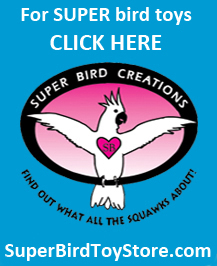- Written by: Deb White
- Category: Health
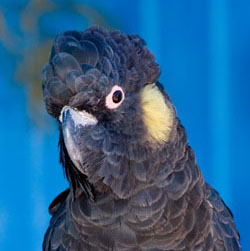 In the event of an emergency, it is important and reassuring to have a properly stocked avian first aid kit on hand. Many minor emergencies can be handled effectively at home if the proper supplies are available. In the event of a more serious situation, the kit can be helpful in stabilizing your bird prior to transport to the vet's office.
In the event of an emergency, it is important and reassuring to have a properly stocked avian first aid kit on hand. Many minor emergencies can be handled effectively at home if the proper supplies are available. In the event of a more serious situation, the kit can be helpful in stabilizing your bird prior to transport to the vet's office.
A commercially available kit is available on the AvianEnrichment site which contains the following:
- 1 - Styptic Powder (stops toenail or broken blood feather bleeding)
- 1 - Pair of latex gloves (to minimize infection)
- 1 - Bottle of Eye & Skin Wash (flush wounds or eyes)
- 1 - 1" x 6 yd. sterile gauze bandage
- 1 - Pair of Scissors (for cutting tape, bandages)
- 1 - Pair of 5" Locking Forceps (to pull broken blood feathers)
- 2 - PVP Iodine Antiseptic Swabs
- 2 - Pkg. 2" x 2" Gauze Pads (to cover wounds or burns)
- 5 - Cotton Swabs (for cleaning wounds)
- 1 - Roll of 1/2" x 2.5 yd. Adhesive Tape
- 1 - Hand Wipe (personal cleanup)
- 1 - Bird Emergency Information Card (vet contact info)
- 1 - Bird Kit Direction Card (helpful emergency info)
In addition to the above contents, we also recommend that you assemble the following supplies for use during an emergency:
- Carrier
- Towel
- Heating Pad
- Flashlight to aid in lighting wounding area, eyes or mouth
- Hand feeding formula or baby food if your bird has stopped eating
- Pedialyte in the event of dehydration
- Disposable plastic feeding pipettes
- Category: Health
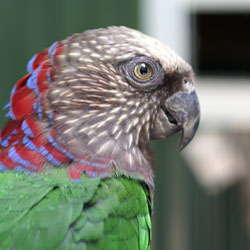 If you have a sick or injured bird there are steps that you can take to help stabilize their condition until you can get them to an avian vet. DO NOT delay in taking action!
If you have a sick or injured bird there are steps that you can take to help stabilize their condition until you can get them to an avian vet. DO NOT delay in taking action!
Rule # 1 is to Be Prepared
By being prepared for an emergency, you can save your parrot's life. This requires:
- Having your avian vet's phone numbers (office and after hours) posted in a convenient location.
- Purchasing or assembling an Avian First Aid Kit.
- Knowing how to safely restrain your bird to prevent further injury or stress.
- Educating yourself on how to deal with basic emergencies.
- Having a heating pad, towel and carrier on hand to safely transport your bird.
In the Event of an Emergency:
- Stay calm as your bird is already very stressed.
- Gently restrain your bird.
- Assess the situation to see if it is something you can handle or if you need to stabilize your bird before transport to an avian veterinarian
- Take appropriate action.
- If your bird appears sick, stabilize your bird by:
- Keeping them warm in an incubator or a small, covered cage placed on a heating pad (set on low temp) or if necessary, a larger cage covered by an electric blanket. Heat is a must for sick birds and the recommended temperature range is 80 - 85°. It allows the bird’s bodily systems to work on fighting the infection rather than on maintaining its body heat.
- Encourage them to eat and drink
- Give them a chance to rest in a quiet, dark room. Sick birds not only need heat but up to 16 hours of restful sleep.
- If your bird is injured, take the appropriate level of action depending on the nature of the emergency (see below)
- Call your Avian Vet as soon as possible for further advice.
Safely Transporting Your Bird
When your bird is sick or injured he is already very stressed. It is important to have a safe, well designed carrier on hand for just this type of situation to keep your bird secure during the trip. During transport you must also keep your bird warm (hot water bottle or heating pad) to ward off shock and covered to keep your bird still and to minimize stress.
How to Deal With Common Emergencies
Note: This section provides only some basic steps to take in the event of a common emergency and is not intended to replace veterinarian care. When in doubt, always call your veterinarian for advice.
Bleeding Beak or Nail
-
- Gently restrain your bird.
- Apply pressure to the area using gauze or a paper towel.
- Apply styptic powder or cornstarch to coagulate the blood
- Watch bird closely over a short period of time to make sure that bleeding doesn’t reoccur.
- If bleeding continues for more than a few minutes call your avian vet.
Broken Blood Feather
-
- Gently restrain your bird.
- Using needle nose pliers or heavy duty tweezers carefully grab the feather shaft close to the skin and gently pull the feather out.
- Apply pressure to the empty feather follicle for 1-2 minutes using gauze or a cotton swab.
- Watch bird closely over a short period of time to make sure that bleeding doesn’t reoccur.
- If bleeding continues for more than a few minutes call your avian vet.
Skin wound
-
- Gently restrain your bird and apply immediate pressure to wound.
- If bleeding does not stop, use styptic powder. You can also use flour, cornstarch or baking powder if you do not have styptic powder.
- Once stopped, clean the wound with antiseptics like, betadine, hydrogen peroxide or chlorhexidine. Use a cotton swab or ball.
- Watch bird closely over a short period of time to make sure that bleeding doesn’t reoccur.
- Seek medical attention in case of continued bleeding or infection.
Animal bites or scratch
-
- Restrain your bird to keep it calm.
- Keep your bird warm.
- Take your parrot companion to veterinarian immediately as such an injury could cause bacterial infections leading to death within 24 hours.
Heat stroke
-
- Place feet in pan of cold water or mist feathers with cold water.
- Seek immediate medical attention.
Hypothermia
-
- Warm the bird by using a heating pad or place bird inside your clothes to capture your body heat. Be careful to not hold too tightly to interfere with breathing.
- Gently rub its feet to increase circulation or place them in warm water.
- Fill your bathroom with hot steam from the shower and hold your bird near.
- Seek immediate medical attention.
Burns
-
- Wash affected area with cold water.
- Dry the bird gently.
- Restrain bird and keep warm to avoid shock.
- Seek immediate medical attention.
Poisoning
-
- If poisoning is from a gas, remove the bird to a safe, well-ventilated area.
- If exposure is due to contact with a chemical, give your bird a bath.
- If exposure was through ingestion, contact your vet immediately with the name of the ingested chemical.
- Seek immediate medical attention.
- Written by: Deb White
- Category: Health
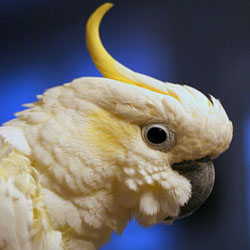 Many veterinarians have not taken the coursework necessary to provide sound medical care to our avian companions. Avian medicine is a specialty and a bird's anatomy and physiology is vastly different from that of dogs and cats. If you own a bird, one of the most critical things you can do to ensure their health is to find a qualified avian veterinarian to provide advice and specialized care.
Many veterinarians have not taken the coursework necessary to provide sound medical care to our avian companions. Avian medicine is a specialty and a bird's anatomy and physiology is vastly different from that of dogs and cats. If you own a bird, one of the most critical things you can do to ensure their health is to find a qualified avian veterinarian to provide advice and specialized care.
There are a few organizations that provide look-up services to find an avian vet in your geographical area.
- The American Board of Veterinary Practitioners (ABVP) provides a listing of board-certified avian veterinarians and the list can be searched at http://www.abvp.com/diplomate .
- The Association of Avian Veterinarians maintains a list of vets who practice avian medicine at http://www.aav.org
- Lafeber and Zupreem also have a lookup services which are very helpful.
If you can't locate an avian veterinarian in your geographical area using these services then you will need to contact your local vets and interview them as to their training and experience in treating birds. Another good approach is to ask local bird owners, breeders or pet stores who they would recommend. Just because a vet isn't listed on these sites doesn't mean they aren't capable of treating your bird. They may have years of experience in treating birds and kept up on the many advances by reading journals or attending conferences.
When considering establishing a relationship with a vet ask the following questions:
- What is the depth of their experience in treating birds?
- Have they taken any specialized training in avian medicine?
- Have they had a bird as a pet?
- Can they provide after hours emergency care?
Remember, if your bird becomes sick or injured, time is always of the essence. Therefore, it is highly recommended that you:
- locate an avian vet long before you ever need one.
- have your vet's office number posted in a convenient spot known to all in your household.
- Category: Health
 Your bird's poop is valuable in providing insight into your bird's health status. A change in the droppings can be your first gauge that something is wrong with your parrot companion.
Your bird's poop is valuable in providing insight into your bird's health status. A change in the droppings can be your first gauge that something is wrong with your parrot companion.
Observation and determination of what is a normal range of variation in your bird's droppings will help you assess when the situation becomes "abnormal". You should note such factors as the frequency, volume, color, texture, shape, and smell of your bird's droppings. The use of white paper, newspaper or wax paper as cage liners for your parrot’s cage will visually display droppings the best. Making a habit of checking your parrot’s droppings daily will serve as a great early detection system for illness.
"Normal" droppings are seen as a long tube in the shape of a coil with clear urine surrounded by white or off white urates. Poop consists of three different components:
- Feces are the dark, firm portion which are usually tubular in shape.
- Urates, the result of digested and metabolized proteins, are typically off-white to yellowish in color.
- Urine, the liquid waste from the kidneys, is the clear liquid portion.
It is important to note that some variation in poop characteristics are natural depending on diet. For example:
- Large amounts of fruit will result in an increase in urine content
- Colored pellets will often result in colored poop.
- Uncolored pellets will result in brown poop.
- A diet high in greens or seed will create green poop.
- Blueberries can result in dark poop.
- Urine output will vary with water intake.
- Urine and urates can pass independently from feces and an all liquid dropping shouldn't be mistaken for diarrhea.
However, some changes in droppings are due to illness: For example,
- The volume of solid poop is an indicator of the volume of food consumed. If the volume of feces drops this may be an indication your bird is not eating.
- If the volume of urine is consistently low this could be the result of dehydration. An increase in urine output often occurs when a bird is stressed.
- The shape of feces is normally tubular (the shape of the intestinal tract). If the feces are unformed this indicates a case of diarrhea.
- The color of the poop is largely influenced by the bird's diet but:
- dark, tarry feces indicate that your bird has stopped eating
- red or dark brown poop could be the result of blood which indicates either internal bleeding, the presence of parasites, poisoning, or tumors
- red or brown urates are indicative of metal poisoning
- green or yellow urates or urine can be an indicator of liver disease or infection.
- Parrot poop typically is not very smelly. If a strong odor is suddenly detected then this could be a sign of illness.
- Unusual texture changes or the presence of undigested seeds can indicate digestive tract problems. Bubbly or foamy looking poop often indicates a clostridium infection.
If the observed changes are consistent for more than 1-2 days and they are not readily explained by dietary variations, then you should consult your avian vet as soon as possible. Be prepared to take fresh samples of your bird's droppings in a plastic bag to your vet's office for further examination.
Write comment (0 Comments)- Category: Health
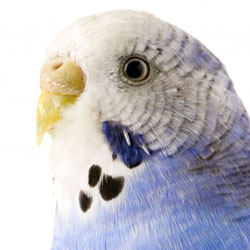 The single most important goal you should have as a responsible parrot owner is to ensure that your bird lives a long, happy and healthy life. The first step to take is to educate yourself and your family about all aspects of bird care. Hopefully, by exploring the info provided in the AvianEnrichment site, you will have a sound overview of the many key physical, emotional and instinctual needs of parrots and how best to address them. Regarding bird's physical health, the basic areas you must address include:
The single most important goal you should have as a responsible parrot owner is to ensure that your bird lives a long, happy and healthy life. The first step to take is to educate yourself and your family about all aspects of bird care. Hopefully, by exploring the info provided in the AvianEnrichment site, you will have a sound overview of the many key physical, emotional and instinctual needs of parrots and how best to address them. Regarding bird's physical health, the basic areas you must address include:
- Providing a well balanced, nutritious diet is the primary key to ensuring optimal health.
- Give your bird opportunities for exercise.
- Develop a knowledge of potential safety hazards in your household (teflon, plants, cleaning supplies, foods) and take preventative measures to avoid accidents.
- Eliminate/reduce sources of stress for your bird.
- Allow your bird to get adequate sleep.
- Maintain a clean cage environment to prevent bacterial and fungal infections
- Observe your bird and determine what is a normal daily routine for your bird. Early detection of health problems will be key to the successful treatment and recovery of your bird in the event of illness.
- Develop a relationship with an avian vet so that s/he is familiar with your bird should an emergency occur. Have your vet perform annual checkups on each of your birds.
- Be prepared in the event of an emergency. Know where to find an avian vet, develop a knowledge of avian first aid basics and have an avian first aid kit on hand.
- Monitor your bird's weight weekly using a scale with a built-in perch. It is very difficult to detect weight loss without the use of a scale due to a bird's feather coat.
- Always quarantine new birds before introducing them to the rest of your flock.
- Category: Health
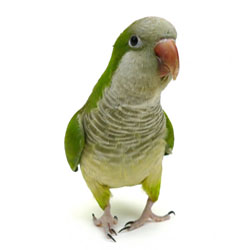 In the wild, parrots have relatively unlimited opportunities to move within their environment, eat when hungry, forage for their favorite delectable, choose their mates and their living quarters, decide when to bathe, when to fly, etc. These natural activities take up the majority of their day. Clearly, parrots did not evolve to spend their lives in a cage or to be limited in their choices. Wild instincts still rule even though most of our birds have been bred and raised in captivity. Thankfully, parrots are extremely adaptable and do a great job at existing within our world. Their adaptability, however, doesn't mean that living in our world isn't a significant source of stress to our birds.
In the wild, parrots have relatively unlimited opportunities to move within their environment, eat when hungry, forage for their favorite delectable, choose their mates and their living quarters, decide when to bathe, when to fly, etc. These natural activities take up the majority of their day. Clearly, parrots did not evolve to spend their lives in a cage or to be limited in their choices. Wild instincts still rule even though most of our birds have been bred and raised in captivity. Thankfully, parrots are extremely adaptable and do a great job at existing within our world. Their adaptability, however, doesn't mean that living in our world isn't a significant source of stress to our birds.
The Danger of Stress
Stress is a physiological reaction to a real or perceived threat. Stress causes a release of hormones that temporarily alters the physical body. This is called the "fight or flight" response. The biological purpose of the hormone release is to heighten awareness, increase strength and activate the immune system to deal with potential injury. When the perceived source of stress is eliminated the biological systems normalize. In situations of chronic stress however, the hormone levels remain high and eventually the immune system becomes impaired which can result in disease and early death.
Sources of Stress
Fortunately, the possibility of stress related health problems can be reduced by careful evaluation and enrichment of their environment. Observation is the key to knowing what is causing stress for your parrot. What is stressful to one bird may not be stressful to another and things that seem relatively minor to us may cause great stress for your bird such as the movement of a ceiling fan or the flickering of a light. Once you can identify the cause of the stress then you can work towards eliminating that source. Common sources of stress include:
- Lack of mental stimulation (boredom)
- Lack of adequate exercise
- Loneliness or lack of interaction with human flock
- Poor nutrition
- Irregular and/or unnatural feeding times
- Poor socialization and lack of behavioral guidance (not knowing how to fit into the human flock)
- Inappropriate cage placement
- Lack of sleep
- Exposure to untrained children, abusive humans and/or pets
- Environmental changes (a move, new cage, new person in home, new eyeglasses on owner)
- Poor environment (cage too small, smoke, noise, emotional stress within family, poor hygiene)
- Loss of owner or mate
- Illness
- Molting
- Nail, wing or beak trimming
Signs of Stress
Individual birds exhibit signs of stress in many different ways. Some of the most common signs are:
- Feather picking or self-mutilation
- Phobic behavior
- Poor appetite
- Inactivity
- Frozen posture
- Personality change
- Easily startled
- Changes in droppings (may also be a sign of illness)
- Uncontrolled aggression
- Screaming
- Obsessive behavior
- Trembling
Reducing Stress
There are many actions we can take to ensure our birds remain healthy and free from undue stress while living within our families. For example:
- Provide a nutritious and varied diet.
- Make sure your parrot has access to food and clean water throughout the day.
- Provide plenty of interesting toys for mental and physical stimulation.
- Provide opportunities for exercise.
- Provide opportunities for foraging.
- Heighten their sense of security by establishing predictable routines and rituals around feeding, bathing, bedtime, social time, morning and after-work greetings and goodbyes.
- RESPECT their needs and desires. Don't force your bird to do something he doesn't want to do.
- Never intimidate or punish a bird.
- Place their cage in a non-threatening location.
- Note things and situations that scare your bird (perhaps vacuum hoses, hats, helium balloons, noises, movement of large objects, etc.) and remove them from the environment to the extent possible.
- Give your birds an opportunity for fresh air and sunshine in an outdoor aviary (Note: be aware of potential outdoor hazards).
- Interact one-on-one with your bird daily and include him in your daily activities to the extent possible.
- Play games and laugh with your bird.
- Have a sleep cage available in another quiet room and make sure that your parrot companion receives plenty of restful sleep.
- Purchase a grooming perch to minimize the frequency of nail trims.
- Play soothing music.
- Keep your emotions in check; birds are very empathic and in-tune with our moods.
- Category: Health
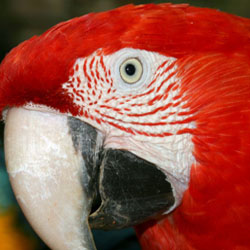 In the wild, displaying any sign of illness is not beneficial to a bird. It is instinctually very important, as a matter of survival, for a bird to disguise sickness. Often, a flock will abandon or drive off a sick bird. Birds that appear weak or ill become easy targets. Unfortunately, the instinct to hide illness also carries over to pet birds and once we notice any sign of illness it usually indicates they have already been sick for some time.
In the wild, displaying any sign of illness is not beneficial to a bird. It is instinctually very important, as a matter of survival, for a bird to disguise sickness. Often, a flock will abandon or drive off a sick bird. Birds that appear weak or ill become easy targets. Unfortunately, the instinct to hide illness also carries over to pet birds and once we notice any sign of illness it usually indicates they have already been sick for some time.
Close and careful observation of your bird's behavior, eating habits, physical appearance and droppings will all provide clues and help you to determine quickly if your bird is not feeling well. Any deviation from your birds “normal daily routine” could indicate a problem.
Things to watch for include:
- Is your parrot eating and drinking it's normal amount each day?
- Is your parrot engaging in his normal level of activity (i.e., talking, singing, preening and playing)?
- Is your parrot remaining at the bottom of its cage?
- Is your parrot sleeping more than usual?
- Has your bird's physical appearance changed?
- Are its feathers fluffed up for long periods without a reason (i.e., cold or sleeping)?
- Are its eyes partially closed or remaining closed the majority of the time?
- Are its feathers malformed? Has it had an incomplete molt?
- Does your parrot display extreme dryness or flaking of the skin?
- Has your bird's posture changed?
- Is your parrot slumped on its perch or having difficulty in perching?
- Is your bird losing weight?
- Are your bird's droppings normal (i.e., color, shape, texture, volume and frequency) for your parrot?
- Does your parrot have difficulty breathing as indicated by open-mouthed breathing or tail bobbing? Do you hear sneezing, wheezing or clicking? Is there discharge from the cere "nose" or eyes?
- Are there any signs of swelling on your bird's body?
- Is there something out of the ordinary inside the cage (i.e., blood droplets)?
Notify your veterinarian immediately if you see any of the signs above. Early detection is the key to maintaining a healthy bird. Do not waste valuable time trying home remedies, if your parrot is ill, time is of the essence. However, In some extreme instances, you may wish to apply first aid or stabilize your parrot before notifying your veterinarian.
Write comment (0 Comments)














































































































































